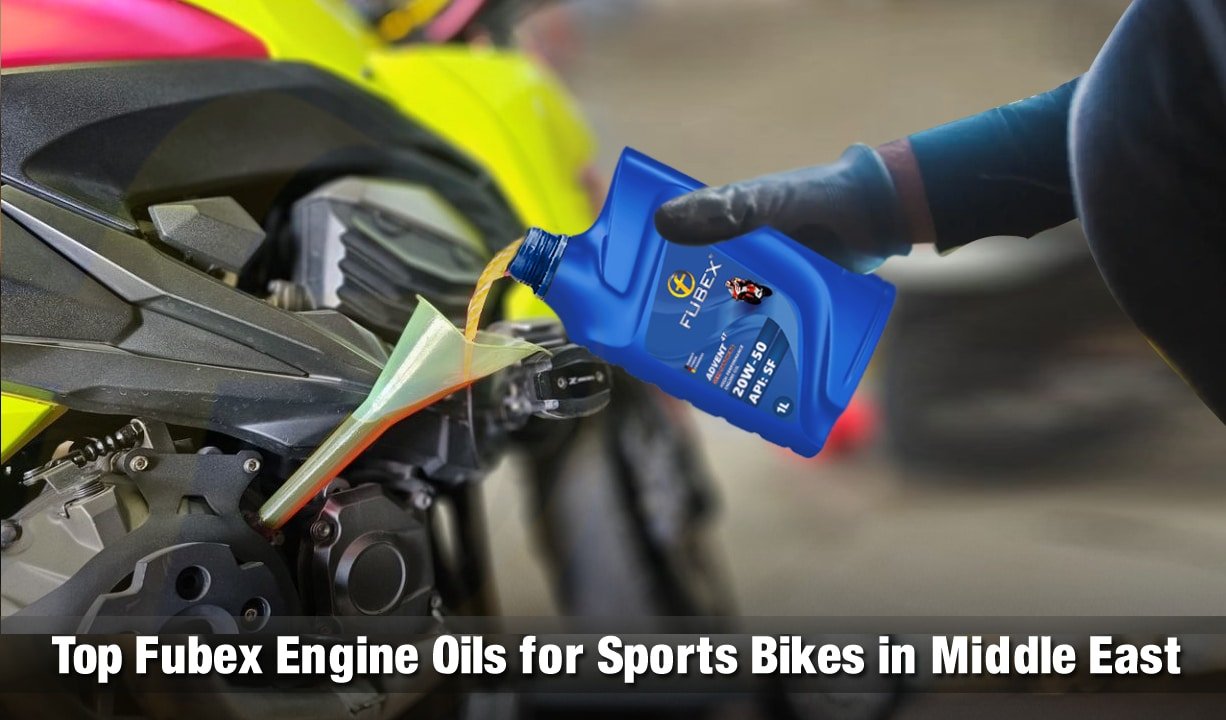
Whether you ride for passion or rely on your bike every day, proper maintenance is key to safety and performance, and one of the most important factors is the engine oil for the bike. The right oil keeps your engine running smoothly, reduces wear, and ensures long-lasting performance, while neglecting it can lead to costly damage.
At Fubex Lubricants, we provide high-quality motorcycle oils for all types of bikes. Enjoy fast shipping, a price match guarantee, and hassle-free returns. Need help choosing the right oil? Call us at +971 50 544 9614, our friendly team is ready to assist!
In this guide, you’ll learn why bike engine oil is essential, how to choose between synthetic and conventional options, and expert tips to help you pick the perfect oil for your riding needs—so your bike stays powerful, efficient, and ready for every journey.
5 Tips for Selecting the Best Engine Oil for Bike
1. Understanding the Basics
As bike riders, we sometimes forget how important engine oil really is. Think of it as the lifeline of your bike—it keeps the engine, the heart of your ride, running smoothly. The right engine oil for a bike isn’t just about reducing friction; it also protects vital parts, boosts efficiency, and extends your engine’s life.
Picking the right engine oil is a choice that directly affects performance and durability. Knowing which oil works best for your bike is like having a map to guide you through the many lubricant options out there. In the next sections, we’ll break it down step by step so you can easily choose the best oil for your ride. At Fubex Lubricants, we’re here to give you clear, expert advice that makes bike maintenance simple and stress-free.
2. Consider Your Bike’s Specific Needs
Choosing the best bike engine oil starts with knowing your bike’s unique requirements. Every bike is different—factors like engine design, size, and how you use it affect the type of oil you need. For example, high-performance bikes often require synthetic oils with the right viscosity grade for better lubrication and cooling. On the other hand, everyday commuter bikes may do well with conventional oils that are more budget-friendly.
Your bike’s owner’s manual is your best guide. It clearly lists the recommended oil type, change intervals, and other important maintenance details. Following these guidelines keeps your engine running at its best, prevents wear, and avoids costly damage.
When searching online for the best engine oil for bike, always match the results to your bike’s specific needs. The right oil choice ensures smooth performance, better protection, and a longer engine life.
3. Know the Oil Grades
To choose the best engine oil for bike, you first need to understand oil grades—especially SAE (Society of Automotive Engineers) viscosity ratings. You’ll often see numbers like 0W-20, 5W-30, or 10W-40 on oil bottles. These numbers show how the oil flows in different temperatures. For example, in 10W-40, the “10W” refers to how well the oil flows in cold weather (W stands for winter), while the “40” shows how thick it stays at normal engine temperature.
Using the right grade matters. If the oil is too thick, it may not flow well during cold starts, causing extra wear. If it’s too thin, it may not protect the engine at high temperatures, leading to overheating and damage. That’s why it’s important to follow your bike’s owner’s manual—it tells you the exact SAE grade recommended for your model.
When you stick to the correct oil grade, you keep your bike running smoothly, prevent engine wear, and extend its life. At Fubex Lubricants, we help you pick the perfect oil grade for peak performance.
Also Read: A Beginner’s Guide to Understanding Multi-Grade Oils and Their Applications
4. Synthetic vs. Conventional Bike Oil
Deciding between synthetic and conventional bike oil is an important choice that affects how well your engine performs and how long it lasts. Each type has its own benefits and drawbacks, and knowing the difference helps you choose wisely. Here’s a quick breakdown:
Synthetic Bike Oil
| Advantages | Disadvantages |
| Provides excellent lubrication across a wide temperature range | More costly compared to conventional oils |
| Resists viscosity breakdown, helping reduce friction and wear | |
| Helps prevent sludge build-up in the engine | |
| Requires less frequent oil changes | |
| Performs reliably in extreme riding conditions |
Conventional Bike Oil:
| Advantages | Disadvantages |
| Affordable and budget-friendly option | |
| Best suited for normal, everyday riding conditions | May not perform as well in extreme temperatures or heavy-duty use |
| Ideal for riders who follow shorter oil change intervals |
In short, synthetic oils deliver better performance and stability, especially for tough riding conditions, while conventional oils are a cost-effective choice for everyday use. The best option depends on how you ride, your maintenance budget, and following your manufacturer’s recommended oil type for proper engine care.
5. Choosing the Right Viscosity
When picking the best engine oil for a bike, viscosity is one of the most important things to understand. Viscosity, shown by the SAE grade, tells you how thick or thin the oil is and how easily it flows. This directly affects how well the oil can protect and lubricate your engine in different temperatures.
In colder weather, a lower viscosity grade like 0W or 5W helps your bike start smoothly. In warmer climates, grades like 10W or 15W keep the oil stable, giving your engine strong protection. The second number in the grade (for example, the 40 in 10W-40) shows how thick the oil stays at normal engine temperature—higher numbers mean better protection in extreme heat.
To choose the right viscosity, think about your local climate, how you ride, and your bike’s specific needs. Always check your owner’s manual for the manufacturer’s recommended SAE grade. Sticking to these guidelines ensures better performance, less friction, and a longer engine life. At Fubex Lubricants, we help you match the perfect viscosity to your riding conditions.
Also Read: How to Choose the Right Viscosity for Your Car’s Engine Oil
Top Recommended Bike Engine Oils
At Fubex Lubricants, we offer a premium range of bike engine oils designed to protect your engine and keep it performing at its best. Our oils work reliably in all conditions—whether you’re riding on a hot summer afternoon or a cold winter morning. They not only shield your engine from wear but also help it run smoother, last longer, and deliver consistent power.
For daily city commutes, our specially formulated Fubex Performance Series ensures smooth starts, better fuel efficiency, and lasting engine protection—keeping you and your bike ready for every ride.
Fubex CLASSIC SAE 20W-50 API
Fubex CLASSIC SAE 20W-50 API: SJ Mineral Motorcycle Oil is an excellent choice for high-speed 4-stroke motorcycles. It improves fuel efficiency, boosts performance, and keeps your engine running smoothly even in tough riding conditions. This oil protects against wear, reduces deposits, and keeps the engine clean, helping it stay strong and reliable for a longer time between oil changes.
Fubex CLASSIC SAE 20W-60
Fubex CLASSIC SAE 20W-60 API is a premium motor oil specially designed for powerful motorcycles that operate in hot climates. It delivers strong protection when your engine is working at its hardest and maintains its stability even under extreme heat. This oil reduces engine wear, prevents deposits, keeps the engine clean, and allows for longer intervals between oil changes—ensuring reliable performance ride after ride.
Fubex SPRING SAE 10W-30 API
SPRING SAE 10W-30 SL is an ester-based mineral oil made for 4-stroke motorcycle engines with wet clutches. It’s specially formulated with the right friction balance to ensure smooth clutch engagement and release at the perfect moment. This oil provides reliable protection, helping your engine and clutch work together seamlessly for better performance and longer life.
Regular Maintenance and Oil Change Tips
Changing your bike’s oil on time is one of the simplest and most effective ways to protect your engine. Always follow the schedule in your owner’s manual, or change the oil sooner if you often ride in tough conditions.
When to Change Bike Oil:
- Follow the mileage or time intervals recommended in your manual.
- Change oil more often in extreme heat, dusty areas, or if you take many short trips.
Why Regular Changes Matter:
- Keeps the engine well-lubricated, reducing friction and wear.
- Improves performance and fuel efficiency.
- Helps critical parts last longer.
Maintenance Tips:
- Check oil levels often and top up when needed.
- Look out for leaks and fix them quickly.
By following these steps, you keep your bike running smoothly, boost performance, and extend the engine’s life. At Fubex Lubricants, we provide quality oils that make every ride smoother and safer.
Also Read: Top 10 Reasons Why Engine Oil Changes Are Essential for Older Cars
Final Takeaways
When choosing the best engine oil for your bike, start with your owner’s manual to find the correct recommendation. Understand the SAE viscosity grade suited to your riding conditions, and compare the benefits of synthetic versus conventional oils. Always select trusted, high-quality brands for consistent performance.
Consider your bike’s specific needs along with the climate you ride in. The right oil not only improves performance but also reduces wear and protects critical components. This ensures a smoother ride and extends your engine’s life.
FAQs
Q1: How often should I change my bike’s engine oil?
It’s best to change your bike’s engine oil every 3,000 to 5,000 miles, or as recommended in your owner’s manual. Riding in extreme heat, dusty areas, or doing frequent short trips may require more frequent oil changes to keep your engine in top condition.
Q2: Should I consider the weather and climate when choosing engine oil for my bike?
Yes. Always choose a bike engine oil with the right viscosity for the temperatures you ride in. Colder climates need lower viscosity oils for smooth starts, while hotter conditions require higher viscosity oils for better protection.
Q3: How do I know the right viscosity grade for my bike?
Check your owner’s manual for the recommended SAE viscosity grade, then match it to the climate and riding conditions you face. This ensures proper lubrication, better performance, and longer engine life.

Editor-at-Large
A passionate writer in the lubricant industry, Awais Iqbal has been covering oils, greases, and industrial fluids since the start of his career. At 25, he’s already written for blogs, catalogs, and brand guides across the UAE. Awais’s insights help companies connect with their audience, and his clear, helpful writing style is trusted by brands in the region.


